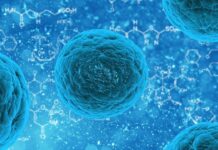When people think about diagnostic tests, many imagine a laboratory full of complex machines and equipment. In most urban centres, labs like these are where samples would be sent to test for food-borne pathogens. But what happens in remote or developing areas without ready access to this technology?
Frédérique Deiss, a post-doctoral fellow in the Derda Research Group at the University of Alberta, wants to be able to bring any type of science that can be found in a super-equipped lab into a very small tent somewhere in the desert, and to give every population in the world the ability to use and to access the technology.
Her current project is the development of a low-cost diagnostic tool made from paper and tape that can detect bacteria, such as salmonella or E. coli, in milk, food and water. Some areas do not have the infrastructure to regularly monitor for food-borne pathogens, so her goal was to create technology that can be applicable in the middle of nowhere.
She chose paper because it is readily available almost everywhere and it is not difficult to train people to construct the tool she has developed on site. Low cost, point-of-care devices for early disease detection or even prevention is the ultimate goal. With this device, farmers could perform the tests themselves every day rather than once a week, and help to prevent people from getting sick.




































